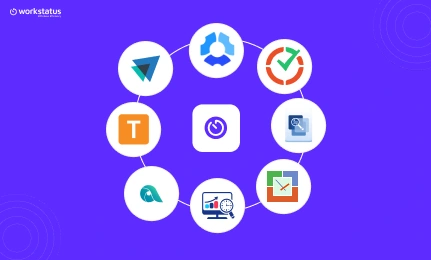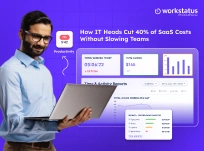Table of Contents
As we know, the digital world has revolutionized our working and living habits. However, it hasn’t altered our need to deliver high-quality items and services.
That’s why enterprises are exploring ways to integrate the transformative power of digital technology into their core operations.
Doing so can help them improve overall workforce performance, streamline processes, and reduce costs, leading to increased productivity, happier employees, and better business outcomes.
Recent statistics show that only 10% of companies currently have an active and effective digital strategy in place.
If your company is lagging, here are some ideas to improve your workforce’s performance through digital transformation.
What is Digital Transformation?
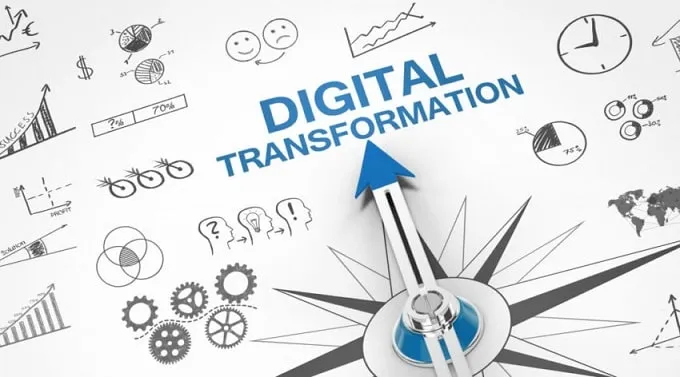
Digital transformation involves transforming an organization to make full use of digital technologies.
It can encompass a broad range of activities, from overhauling IT systems and processes to rethinking how an organization works together to serve customers or deliver value to shareholders.
It can be a top-down or bottom-up approach, and it may or may not involve the generation of new revenue streams.
People often ask us how they can use information technology more effectively. It’s a great question, and one we want to answer in an easy-to-digest way.
In that vein, here are five steps organizations should take if they want digital transformation:
- Put leadership in place.
- Use your current platforms.
- Leverage data and analytics.
- Invest in people, processes, and tools.
- Don’t forget change management.
The exciting news is that many companies have already started making changes across their organizations as IT infrastructures evolve with technologies like cloud computing.
Moreover, workforce-management software vendors will continue building products for digital workplace environments.
Regardless of where you sit in your organization, there is undoubtedly value for everyone, from leaders and business units to HR departments, in modernizing workflows by leveraging information from new systems.
While it takes some time to integrate all these pieces, the benefits include increased productivity, revenue growth, and improved employee engagement.
Also Read: Remote Jobs: The Top 10 Analysis & Statistics
Why Do Businesses Need It?

Improvements in technology have allowed companies to streamline their businesses and become more efficient than ever before. Businesses that don’t use new digital technologies will be left behind as competitors start using them to reach new customers and create fresh, innovative ways of doing business.
This can threaten long-standing organizations—particularly those in slow-moving industries, such as manufacturing or utilities.
If these companies fail to invest in technology, they may find themselves outpaced by competitors who know how critical it is for businesses today to innovate constantly.
Given how transformative digital transformation can be for businesses across every industry, organizations must keep pace with it and develop strategies for ensuring all staff members are on board.
One way is to implement clear internal communication channels so staff members know what they need to do—and when they need to do it—to adapt successfully when change happens within an organization.
Who Does It Impact?
It is essential that employees at all levels within an organization help with digital transformation initiatives because of their impact on business operations.
That includes high-level executives and managers, along with front-line workers like customer service representatives and administrative assistants.
Everyone needs time and training to figure out precisely what changes will occur to align their efforts toward meeting company goals.
The First Step To Transforming Your Business
The two most important things you should keep in mind during a digital transformation are: What are we doing? Why are we doing it?.
You must know what exactly your business will transform into, who will be involved, how you’re going to get there, and why it’s necessary.
Ask yourself: What information or services do customers seek? How can they get these faster or easier? Can we use technology to automate that process? If so, is it possible for us to create a tool or improve an existing one? How can we increase efficiency and reduce cost?
Make sure every team member understands how they fit into your vision. Without clear communication of goals, workflows, tasks, processes, etc., no project will successfully create real value.
How can digital transformation improve workforce productivity?

We’ve been hearing all about big data for a while now, but in practice, many companies are still just scraping by with antiquated analytics methods.
The truth is that if you don’t want your business to get left behind, you need to look at emerging tech trends such as machine learning and artificial intelligence (AI) for ways of improving your workforce performance through digital transformation.
Advances in Machine learning (ML) and AI can help with everything from organizational decision-making to personal communication, so it’s only natural that they could also help optimize workforce performance.
These trends can help you gain new insights into how and where work is being done and make wise use of time and resources overall.
Implementing these new technologies isn’t easy, but it can have a significant impact on your workforce’s productivity–not to mention its morale!
Don’t be afraid to embrace these new systems, but do be cautious: If your company doesn’t implement them correctly from day one, you might find yourself needing an entirely new team to update them later down the line.
To start making sense of everything, you should consider first figuring out what type of infrastructure works best for you.
Whether locally or hosted remotely, there are advantages and disadvantages to each option so take time researching the pros/cons before deciding which system is right for your organization.
Sign up to try the best workforce tracking app here-
Also Read: Procrastination vs. Productivity: What Does The Future of Work Look Like?
What Do You Have To Measure When Improving Performance?
A powerful AI-enabled workforce management software will allow you to measure the following data to improve the performance of your workforce-
1.User Activities
The first step to improving employee performance is understanding what each employee does and how those activities tie into company goals, known as user activities.
These include all the tasks an employee performs during a given day, from arriving at work until leaving for home.
Many companies use employee monitoring software that automatically tracks these activities.
However, if such software is not available or you only use some of its features, manually monitoring the time spent on various tasks will suffice as long as you do it regularly.
2. Employee Engagement
This is one of your first steps in understanding what you have to measure and improve for performance improvement.
Engaged employees tend to work harder and more efficiently, saving time and effort for the company. Engaged employees understand the significance of their role in helping achieve business goals.
They have a positive attitude toward their daily tasks and responsibilities and are a valuable source of information, suggestions, and collaboration with other employees. They recognize how they can contribute to success by actively achieving goals or completing projects.
3. Company Success Metrics
Along with providing a simple way to focus on progress, company success metrics create a space for growth by establishing goals and measuring them regularly.
Start by selecting one key metric that is most important to your business and measure it over time. For example, if you decide that customer retention is critical, you can set a goal of keeping customer retention at 90% or above.
4. Project Completion Rate
If your project completion rate is high, it means you are doing good work. If it is low, you may want to investigate why a large number of projects are falling through.
While quality is always more important than quantity, your business will have fewer headaches and be more successful if you can deliver both.
Ask yourself questions like: What could we be doing better? Where can we improve? What mistakes do we keep making over and over again? If you have all the data available at your fingertips, you can avoid missing red flags.
One aspect that businesses often struggle with when reaching optimal performance levels is time tracking.
Time-tracking software for employees and projects streamlines workflows, so you know how much time employees spend on each task, helping businesses recognize areas where they need improvement.
5. Customer Journey Analytics
Workforce Management Software can identify your most valuable customers by level. In other words, it can determine if one customer is worth twice as much as another.
It can help you get a fair idea of how much you should invest in each customer to keep them loyal. Track their behavior and make notes about what is working and what is not.
That way, you can identify opportunities to improve service over time. Ultimately, the goal is to eliminate all hassle points along their journey.
6. Productivity Rates
Productivity is doing your job well and efficiently. Before you can gauge how well you are performing at work and whether you need to improve, you first have to know how fast you are working now.
It may seem enough to clock in and out when you come into work, but what about all those minutes that pass between meetings? How much time do you spend walking around trying to figure out what needs to be done next? Are there tasks taking longer than they should? Are there factors slowing down the workflow that could be addressed?
Some managers keep track of these details on paper on their desks, while others use spreadsheet software stored on their computers.
Also Read: Growth Strategy Checklist: Plan Your Business Goals With These 5 Tips
Workstatus- Getting Started With Data Tracking And Analytics
1. Time Tracking
![]()
Track your productivity by measuring time on tasks. Time tracking software for employees is an excellent way to manage work-life balance, as it offers greater insight into how you spend your time and can help you identify where time is being wasted.Workstatus offers additional features like screenshots or activity levels that enable managers to verify that employees are working during certain times.
2. Remote Employee Monitoring
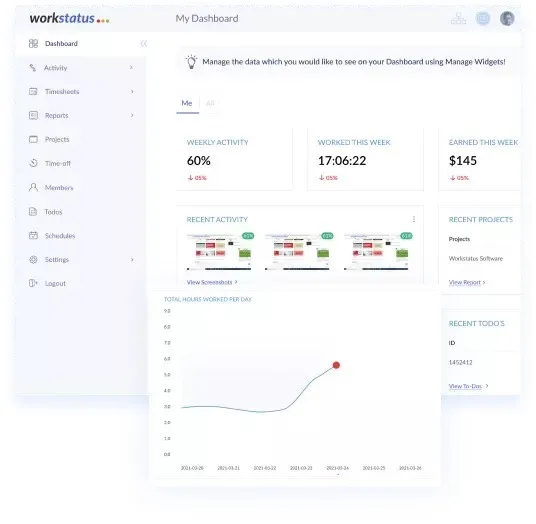
Even one remote employee is a lot to manage for small to mid-sized organizations. If you have someone working from home or another location, managing their schedule and productivity is crucial as it is challenging to monitor remote employees.Remote workforce management software—like Workstatus’ new mobile time clock feature—helps you track their hours and see when they last checked in or out. You can also issue alerts if an employee hasn’t clocked in for a few days.
3. User Activity Monitoring
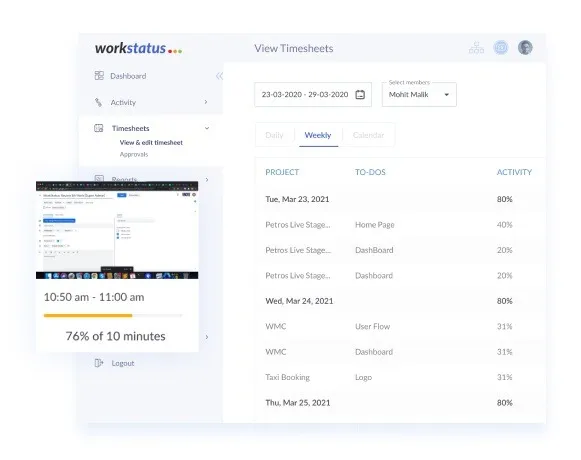
We understand that the following questions always keep your mind busy –
Who is logged in, and what are they doing? Are they active or passive users? What work did a user perform over a period of time (month, quarter)?
But don’t worry!
Workstatus provides the following key details while monitoring user activity:
- Collect metrics to identify trends, peaks, and valleys.
- Report on one or multiple locations.
- Key Users Report.
- Compare your top users by key features, including Date, Time, etc.
You can leave your unnecessary problems behind and stay focused on your goals and commitments.
4. Online Timesheets
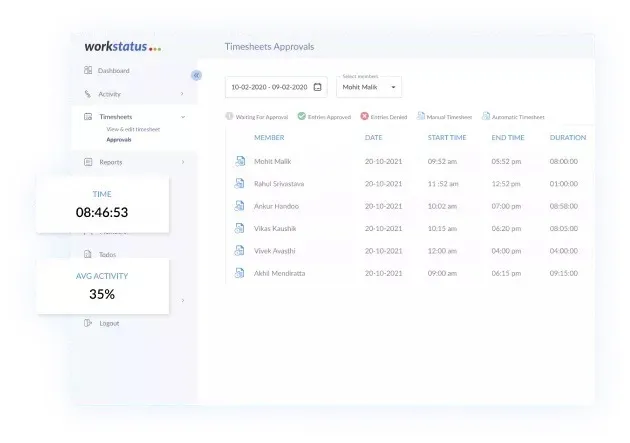 To track and bill for time accurately, you need accurate data about your team’s working hours. It might sound simple, but companies lose more than $600 billion a year on misreported timesheets.
To track and bill for time accurately, you need accurate data about your team’s working hours. It might sound simple, but companies lose more than $600 billion a year on misreported timesheets.
Instead of guessing how much time is spent on any given task, use online timesheets to monitor productivity and ensure people are being paid correctly.
Such platforms also provide flexibility, allowing employees to record their work from anywhere at any time.
5. Attendance Management
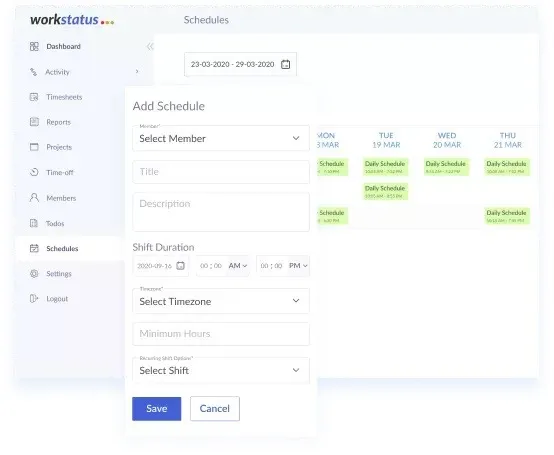
Employees are willing to work in an environment where they are valued, respected, and appreciated.
A cloud-based workforce management system that provides real-time reporting will help ensure you know who is working or not, who has permission to be absent, and which employees are working in timesheets they shouldn’t be.
Workstatus provides clock-in and clock-out with selfie validation to make it easier to keep track of your employee attendance and productivity levels.
This way, managers can analyze information like late arrivals, early departures, and hours worked during different periods throughout a given day.
6. Productivity Measurement
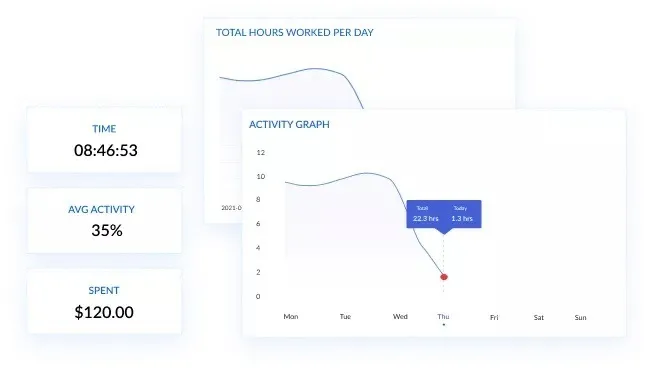
If a company wants to improve productivity, it needs to have a way to measure it. The good news is that all time-based tracking software like Workstatus has a feature for precisely measuring productivity.
It includes each employee’s start and end times, length of breaks in between workdays, number of hours spent on specific projects, and so forth.
Such information is critical to making an informed decision on how much every worker produces every day.
Closing Thoughts
The first step to digital transformation is changing your mindset. It’s not a one-time event but an ongoing process of self-reflection and improvement as you move forward with the necessary changes for success in today’s business environment.
In this blog post, we’ve outlined some ways that companies can start improving their productivity by using data tracking and analytics tools like Workstatus to improve performance rates across all areas of your company from customer journeys, project completion rate, and employee engagement level, just by tracking user activities or time spent on projects for remote employees.
Request a free demo of the best workforce monitoring software and get familiar with the workforce management techniques
Thanks for reading!!
FAQs
1. What is digital transformation, and how can it improve workforce performance?
Digital transformation is the process of using digital technologies to transform the way a business operates. It can involve the adoption of new software, tools, and processes to streamline workflows, automate tasks, and improve collaboration.
By implementing digital transformation initiatives, businesses can improve their workforce performance in several ways.
For example, they can increase productivity by automating repetitive tasks, enhance collaboration and communication by using digital tools, and improve decision-making by accessing real-time data.
2. What are some of the challenges businesses may face when implementing digital transformation initiatives to improve workforce performance?
While digital transformation can bring significant benefits to a business, it can also pose some challenges during implementation.
Some of the common challenges businesses may face include:
- Resistance to change from employees
- Lack of digital skills and knowledge
- Data security and privacy concerns
- Need for significant investments in technology infrastructure
To address these challenges, businesses should prioritize employee training and education, develop a clear digital transformation strategy, invest in secure and reliable technology solutions, and involve employees in the change process to ensure buy-in and adoption.





